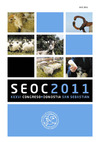Please use this identifier to cite or link to this item:
https://accedacris.ulpgc.es/handle/10553/107390
| DC Field | Value | Language |
|---|---|---|
| dc.contributor.author | Camacho, A. | en_US |
| dc.contributor.author | Capote Álvarez, Juan Francisco | en_US |
| dc.contributor.author | Torres, A. | en_US |
| dc.contributor.author | Mata, J. | en_US |
| dc.contributor.author | Argüello Henríquez, Anastasio | en_US |
| dc.contributor.author | Bermejo, L.A. | en_US |
| dc.date.accessioned | 2021-06-04T11:04:45Z | - |
| dc.date.available | 2021-06-04T11:04:45Z | - |
| dc.date.issued | 2011 | en_US |
| dc.identifier.isbn | 978-84-615-4134-8 | en_US |
| dc.identifier.uri | https://accedacris.ulpgc.es/handle/10553/107390 | - |
| dc.description.abstract | Se valoraron 192 muestras del músculo Semimembranosus de la raza Canaria y la raza Canaria de Pelo. Para cada raza se estudiaron 32 muestras de carne de corderos de 10, 16 y 24 kg de peso vivo. Las funciones canónicas obtenidas no fueron significativas, por lo que no discriminaron las distintas canales (raza*peso). Ambas razas presentaron una carne con valores medios en apariencia global, olor, flavor, dureza, elasticidad y una jugosidad, y una baja untuosidad. En el análisis de varianza, sólo se encontraron diferencias significativas entre razas en la apariencia global, obteniendo la raza Canaria el valor más alto. La dureza y la elasticidad estuvieron altamente correlacionadas entre sí (R = 0,733). Las variables sensoriales que más importancia tuvieron en la apreciación global de la carne fueron el flavor y la dureza. | en_US |
| dc.language | spa | en_US |
| dc.publisher | Sociedad Española de Ovinotecnia y Caprinotecnia (SEOC) | en_US |
| dc.source | SEOC 2011 : XXXVI Congreso, Donostia, p. 225-228 | en_US |
| dc.subject | 3104 Producción Animal | en_US |
| dc.title | Calidad sensorial de la carne de dos razas ovinas locales canarias | en_US |
| dc.type | info:eu-repo/semantics/lecture | en_US |
| dc.type | Lecture | en_US |
| dc.relation.conference | XXXVI Congreso de la Sociedad Española de Ovinotecnia y Caprinotecnia, (SEOC 2011) | en_US |
| dc.description.lastpage | 228 | en_US |
| dc.description.firstpage | 225 | en_US |
| dc.investigacion | Ciencias de la Salud | en_US |
| dc.type2 | Ponencia | en_US |
| dc.utils.revision | Sí | en_US |
| dc.identifier.ulpgc | Sí | en_US |
| dc.contributor.buulpgc | BU-VET | en_US |
| dc.contributor.buulpgc | BU-VET | en_US |
| dc.contributor.buulpgc | BU-VET | en_US |
| dc.contributor.buulpgc | BU-VET | en_US |
| item.fulltext | Con texto completo | - |
| item.grantfulltext | open | - |
| crisitem.event.eventsstartdate | 06-10-2011 | - |
| crisitem.event.eventsenddate | 07-10-2011 | - |
| crisitem.author.dept | GIR IUSA-ONEHEALTH 4. Producción y Biotecnología Animal | - |
| crisitem.author.dept | IU de Sanidad Animal y Seguridad Alimentaria | - |
| crisitem.author.dept | Departamento de Patología Animal, Producción Animal, Bromatología y Tecnología de Los Alimentos | - |
| crisitem.author.orcid | 0000-0002-4426-0678 | - |
| crisitem.author.parentorg | IU de Sanidad Animal y Seguridad Alimentaria | - |
| crisitem.author.fullName | Capote Álvarez, Juan Francisco | - |
| crisitem.author.fullName | Argüello Henríquez, Anastasio | - |
| Appears in Collections: | Ponencias | |
Page view(s)
98
checked on Jan 4, 2025
Download(s)
24
checked on Jan 4, 2025
Google ScholarTM
Check
Altmetric
Share
Export metadata
Items in accedaCRIS are protected by copyright, with all rights reserved, unless otherwise indicated.
